Abstract
Flooding is an issue that affects many cities during periods of heavy rain, especially in developing countries. This issue often happens due to the lack of timely maintenance and cleaning of rainwater drains. This work presents a proposal to detect blockages in rainwater drains to determine where maintenance and cleaning need to be performed promptly. An architecture that includes sensor nodes, a Gateway, and a cloud application was defined. The sensor nodes, which detect potential blockages in the drains, send data and status signals to the Gateway using LoRaWAN. The Gateway then passes the data to a cloud platform that records the data and issues an alert when a blockage is detected in a drain. The sensor node prototype is based on a Heltec LoRa WiFi board and has two sensors: an HC-SR04 ultrasonic sensor to measure distance and a DHT22 sensor to measure humidity and temperature. The cloud application was developed on the Arduino Cloud platform. A decision tree is proposed to detect blockages based on the readings from these sensors, particularly the distance sensor, considering four main possible states: clear, possibly blocked, potentially blocked, and blocked. The decision tree is implemented in each node. Periodically, the node collects data from the sensors and transmits them to the cloud, and if a potential blockage is detected, it sends a message that triggers an alert on the platform. Preliminary tests of the prototype show accurate and timely results in detecting potential blockages, allowing for a better use of resources allocated for maintaining drainage systems.
1. Introduction
Efficient stormwater management in urban areas is essential to prevent flooding and minimize damage to city infrastructures. One of the main challenges in this context is detecting and mitigating blocked storm drains, which can lead to significant water accumulation during intense rain events. The Internet of Things (IoT) technology offers an innovative solution to this problem by enabling real-time monitoring and early detection of obstructions.
The implementation of IoT sensors in storm drains allows for the continuous collection of data on water flow and the presence of blockages. Recent studies have demonstrated the effectiveness of these systems in urban water management. For example, integrating water level and pressure sensors with IoT networks has enabled the detection of blockages with high precision, significantly reducing the need for manual intervention for maintenance [,]. Another study highlighted that combining IoT technology with geographic information systems (GISs) can significantly improve flood emergency planning and response []. On the other hand, IoT can be used for storm drain blockage detection, as well as monitoring clogging swage systems [].
Furthermore, IoT-based systems have proven to be not only effective in detecting blockages but also cost-efficient and straightforward to implement []. This underscores the practicality and feasibility of adopting IoT technologies to detect blockages in storm drains, representing a significant advancement in urban water management.
This paper introduces a proposal for an IoT system that allows for the timely detection of blockages in storm drains. This system aims to optimize the resources invested in their maintenance and cleaning. It will help to prevent flooding in urban centers caused by storm drain blockages and overflows, warning when a drain blockage is detected. The rest of the article is structured as follows: Section 2 presents a brief description of the methodology of this work, Section 3 describes the proposed system, followed by the results of the preliminary tests in Section 4, and lastly, the conclusions are presented.
2. Methodology
First, a literature review was conducted to understand what previous proposals existed for detecting blockages in storm drains. With this in mind, the general system scheme was first developed, followed by the sensor node design, which would detect the blockages.
After the design, a prototype of the sensor node, which will be placed in the drain, was built. Then, the cloud application that would receive and record the obtained data from the drains was programmed. The method by which the sensor node determines if a blockage exists and sends the respective alert to the cloud platform was established. The decision tree was implemented through a decision tree based on the sensor readings of the node.
Once the prototypes were created, their functionality was tested in a controlled environment and then in a stormwater drain.
3. Proposal
3.1. System Design
The proposed system has three main components, as shown in Figure 1. These components are the following:
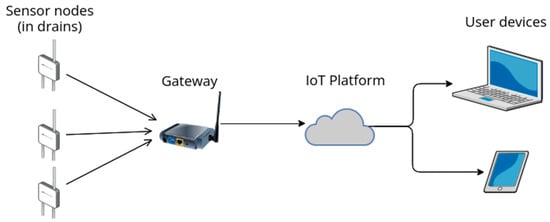
Figure 1.
Diagram and components of the Blockage Detection System.
- Sensor node;
- Gateway;
- IoT platform.
In Figure 1, the first component, the sensor node, is shown. This node will collect data from the integrated sensors and periodically send it to the IoT platform through a Gateway. This Gateway will receive the data from the sensor nodes using wireless communication (LoRaWAN, SigFox, NB-IoT, or another) and pass the data to the IoT platform on the Internet. This cloud-based platform receives all this information and notifies when a node detects a possible blockage. Additionally, the platform allows the system user to visualize the information using a PC or mobile device and to make decisions based on these data.
For the proposal, the sensor node has two sensors: a distance sensor and a temperature and humidity sensor. These sensors are connected to a microcontroller board, as shown in Figure 2. In addition to the sensors, the microcontroller board incorporates a wireless transceiver to transmit data and alerts.
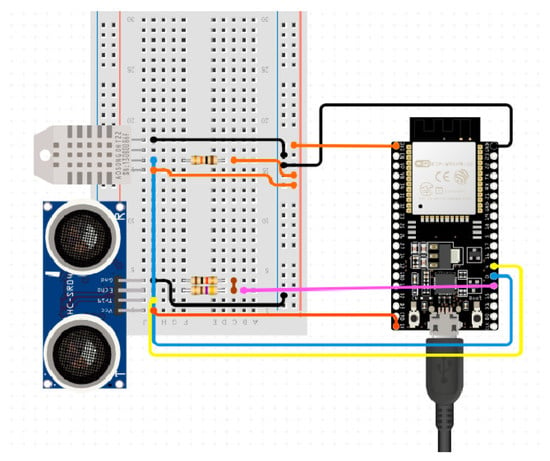
Figure 2.
Diagram of sensor node components.
A decision tree was designed for blockage detection based on three measurements taken from the sensors: distance, humidity, and temperature. The decision tree, shown in Figure 3, considers first the distance, then the humidity, and lastly the temperature to obtain an estimated state. The distance parameter was taken as if the distance from the node to the bottom of the drain was 90 to 100 cm. This parameter must be adapted to the dimensions of each drain, proportionally calculating the values in Figure 3. It should be noted that the humidity and temperature values considered in Figure 3 are focused on a city near the coast near latitude 0. These values should change for other places (with different altitudes and/or geographical latitudes).
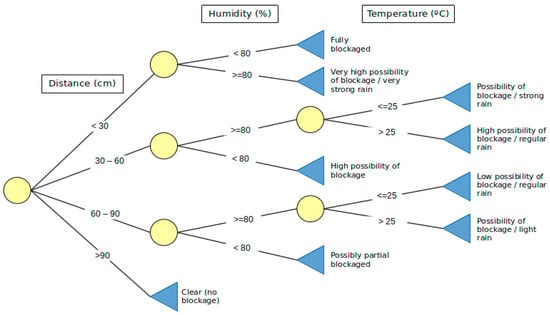
Figure 3.
Decision tree for blockage detection.
In the decision tree in Figure 3, nine possible results can be obtained. In order to simplify its implementation in the sensor node, the possible results have been reduced to four main states, which will be notified to pertinent personal: clear, possibly partial blockage, potentially blocked, and blocked. A “Clear” state is equivalent to a non-blockage, only this state does not have notifications. A “Possibly partial blockage” means that a partial or temporal blockage is detected, or maybe it is raining. “Potentially blocked” implies that there is a considerable obstruction or there is intense rain. “Blocked” means the drain is obstructed, i.e., a drain blockage is detected. Table 1 shows the equivalence between these primary states and decision tree results.

Table 1.
Equivalence of the decision tree results in a drain state.
3.2. Prototype Implementation
For the prototype implementation, we consider the system requirements accomplished, costs, and availability of components in the local market. LoRaWAN technology was considered for communication between sensor nodes and the Gateway.
Figure 4 shows both the sensor node and Gateway prototypes. Both devices were deployed in a protective case, to protect them against damage or external threats.
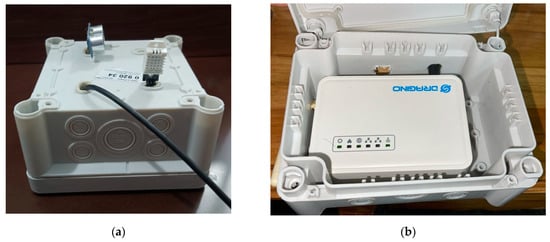
Figure 4.
(a) Sensor node prototype, with both distance and temperature/humidity sensors, in its protective case; (b) LoRaWAN Gateway used in prototype.
The main components selected for sensor node were the following:
- DHT22 sensor: an air humidity and temperature sensor [].
- HC-SR04 ultrasonic sensor: a distance sensor based on ultrasonic measurements [].
- Heltec WiFi Lora 32 board: an ESP32 microcontroller development board with a LoRaWAN transceiver chip [].
The sensor node was programmed to take measurements every determined time (a few minutes in preliminary tests, 8–24 h in a deployment) and go to a low-power mode to save energy because it is powered with batteries.
In addition, a Dragino LG01-N LoRa device [] was used as the Gateway between sensor nodes and the cloud IoT Platform.
The IoT platform was developed using the Arduino Cloud service. Device (sensor node) connections, data storage, information dashboards, and event triggers were configured here. The dashboards show historical and current sensor measurement data taken by the nodes. The triggers send email notifications about events related to drain blockage to the people who must take action regarding this issue.
4. Results and Discussion
4.1. Preliminary Results
Once the prototype was developed, some tests were performed to verify the function of all components. The initial tests were focused on the proper operation of sensors, communication, and the IoT platform. For this, several measurements were conducted, changing the distance and verifying the data in the cloud and the notification triggers. Figure 5 shows information from a sensor node on the platform. In this figure, we can see both historical and current information.
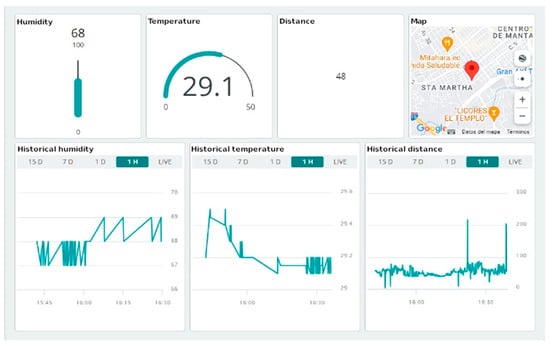
Figure 5.
Dashboard with sensor node information in the IoT cloud platform.
After the operation verification, a sensor node prototype was located in a stormwater drain to test it in an actual environment (Figure 6). The test ran for four days, and the node was configured to take one daily measurement. Table 2 shows the data obtained from this test. Only on the first day did the node report a “possibly partial blockage”. Indeed, a light rain occurred that day. The rest of the days, the weather was sunny with no rain. The difference in distance measurements over the rest of the days can be a consequence of the level of accuracy of the ultrasonic sensor.
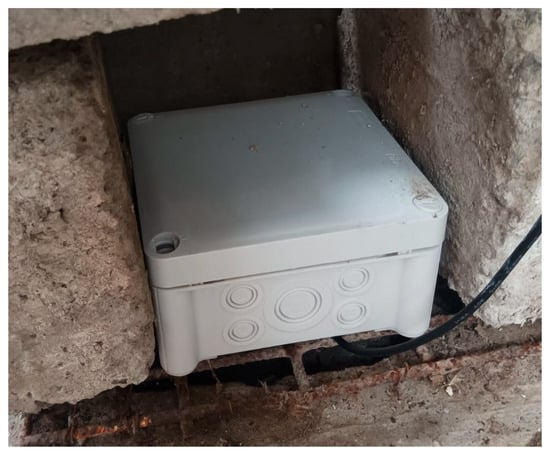
Figure 6.
A sensor node located in a stormwater drain for tests.

Table 2.
Obtained data from the test in a real stormwater drain.
4.2. Discussion
Instead of monitoring sewage pipes to detect blockages, as proposed in works such as [], [], or [], our proposal is focused on detecting blockages in drains, taking advantage of their trap bottoms to catch soil and garbage before they go to pipes.
Previous works have applied techniques like artificial intelligence (AI) for detecting blockages using several operations, such as in []. Using a decision tree is a novel and light option because it can be easily implemented in the node. Nevertheless, to reduce the operation load in the node, the decision tree could be implemented in the IoT cloud platform instead of the sensor node.
LoRaWAN communication demonstrates to be an adequate option to communicate the nodes with the rest of the system because of its range and low power capacities. As the node is close to the surface, the transmission is not mainly affected by ground dielectric properties []. However, other communication options, such as GSM [], can also be considered.
5. Conclusions
This work presents a proposal for monitoring stormwater drains to detect blockages promptly. The proposal includes a sensor node (located in drains) and a cloud platform that stores and presents information about drain states and notifies when a possible blockage is detected.
The preliminary test demonstrated the proposed system’s functionality and suitability, both in terms of accuracy and applicability. The platform notified when the sensor node detected that one of the decision tree conditions had been accomplished.
Future work could try other AI techniques to detect blockages, either alone or combined. In addition, the detection operation could be moved to another part of the system, such as the Gateway or the IoT platform.
Moreover, additional experiments must be conducted to determine the most convenient combination of hardware and communication technology in order to optimize battery use. Other more precise sensors can also be tested to obtain more accurate data.
Author Contributions
Conceptualization, M.N.; methodology, M.N., J.M.-A. and D.Q.-C.; hardware assembly and programming, J.M.-A. and D.Q.-C.; cloud platform, J.M.-A. and D.Q.-C.; tests and validation, J.M.-A. and D.Q.-C.; writing—original draft preparation, M.N.; writing—review and editing, M.N., J.M.-A. and D.Q.-C.; supervision, M.N. All authors have read and agreed to the published version of the manuscript.
Funding
This research received no external funding.
Institutional Review Board Statement
Not applicable.
Informed Consent Statement
Not applicable.
Data Availability Statement
Data sharing is not applicable to this article.
Conflicts of Interest
The authors declare no conflicts of interest.
References
- Talukder, S.; Sakib, M.I.I.; Talukder, Z.R.; Das, U.; Saha, A.; Bayev, N.S.N. USenSewer: Ultrasonic Sensor and GSM-Arduino Based Automated Sewerage Management. In Proceedings of the 2017 International Conference on Current Trends in Computer, Electrical, Electronics and Communication (CTCEEC), Mysore, India, 8–9 September 2017; pp. 12–17. [Google Scholar]
- Priyanka, Y.K.; Gowtham, M.; Yashashwini, C.; Yashashwini, C.B.; Yashashwini, H.C. Detection and Get Rid of Blockage in a Manhole Pipe Using IoT. In Proceedings of the 2020 International Conference on Recent Trends on Electronics, Information, Communication & Technology (RTEICT), Bangalore, India, 12–13 November 2020; pp. 204–207. [Google Scholar]
- Bhosale, P.; Mithapelli, S.; Bollabattin, S.; Patel, R.; Bhalerao, A.; Patil, D.D.D. IoT based system for detection of sewage blockages. Inf. Technol. Ind. 2021, 9, 961–970. [Google Scholar] [CrossRef]
- Bhutada, S.; More, S.; Shrivastav, T.; Suryawanshi, C.; Suryawanshi, P. IoT Based Smart Sewage Monitoring System for Smart City. Ijraset J. Res. Appl. Sci. Eng. Technol. 2022, 10, 1702–1707. [Google Scholar] [CrossRef]
- Khanke, A.; Naik, A. Autonomous Anti-Clogging Sewerage System Using IoT. In Proceedings of the 2020 International Conference for Emerging Technology (INCET), Belgaum, India, 5–7 June 2020; pp. 1–4. [Google Scholar]
- Liu, T. Digital-Output Relative Humidity & Temperature Sensor/Module DHT22. 2010. Available online: https://www.sparkfun.com/datasheets/Sensors/Temperature/DHT22.pdf (accessed on 20 August 2024).
- Elecfreaks Ultrasonic Ranging Module HC—SR04. 2011. Available online: https://cdn.sparkfun.com/datasheets/Sensors/Proximity/HCSR04.pdf (accessed on 20 August 2024).
- Heltec Automation WIFI LoRa 32 (V3). Available online: https://heltec.org/project/wifi-lora-32/ (accessed on 4 March 2024).
- Dragino LG01-N—Single Channel LoRa IoT Gateway. Available online: https://www.dragino.com/products/lora/item/143-lg01n.html (accessed on 20 August 2024).
- Hussin, Z.M.; Saaddin, S.S.; Mohammad, S.; Azmi, N.A.M.; Salim, S. Development of Automated Drainage System. In Proceedings of the 2022 IEEE International Conference on Automatic Control and Intelligent Systems (I2CACIS), Shah Alam, Malaysia, 25 June 2022; pp. 72–77. [Google Scholar]
- Rocher, J.; Rego, A.; Lloret, J.; Oliveira, L.M.L. Use of Wireless Sensor Network System Based on Water Level, Rain, Conductivity, Oil and Turbidity Sensors to Monitor the Storm Sewerage. IET Wirel. Sens. Syst. 2022, 12, 103–121. [Google Scholar] [CrossRef]
- Misra, D.; Das, G.; Das, D. Artificial Intelligent Based Smart Drainage System. Res. Sq. 2022. [Google Scholar] [CrossRef]
- Raza, U.; Salam, A. Wireless Underground Communications in Sewer and Stormwater Overflow Monitoring: Radio Waves through Soil and Asphalt Medium. Information 2020, 11, 98. [Google Scholar] [CrossRef]
Disclaimer/Publisher’s Note: The statements, opinions and data contained in all publications are solely those of the individual author(s) and contributor(s) and not of MDPI and/or the editor(s). MDPI and/or the editor(s) disclaim responsibility for any injury to people or property resulting from any ideas, methods, instructions or products referred to in the content. |
© 2024 by the authors. Licensee MDPI, Basel, Switzerland. This article is an open access article distributed under the terms and conditions of the Creative Commons Attribution (CC BY) license (https://creativecommons.org/licenses/by/4.0/).